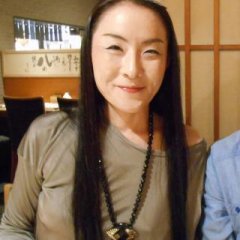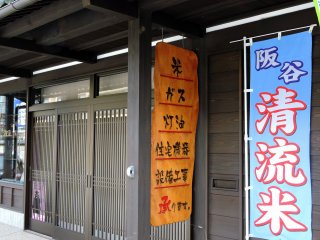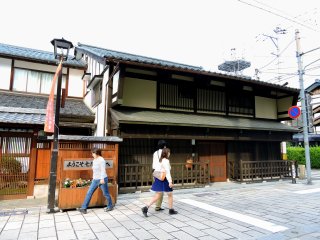When I visited Ono Castle in Fukui, I parked my car in 'Ono Castle Town East Square' and walked down a street called 'Shichiken Street'. On this street, a famous morning market has been held for more than four hundred years. It's open from 7 am to 11 am EVERYDAY from Vernal Equinox Day (March 20 or 21) to the end of a year (December 31). Since I didn't know about it, I arrived there in the late afternoon and missed the activity. However, this street is filled with the atmosphere of old Japan, and just walking along it was such a pleasure. I almost felt like I was in Kyoto, not in Fukui. Kyoto minus crowds, that's Shichiken Street!
- 1 min read
Shichiken Street in Ono Castle Town
Like Kyoto without the crowds

Community writer

Front view of one of the shops on Shichiken Street in Ono Castle Town

Very Japanese-looking shop sign says, 'Rice, gas, heating oil, house appliance, equipment installation work and more'...this shop seems to be a jack-of-all-trades!

This beautiful Japanese stone marker says 'Shichiken Street'

People leisurely strolling on Shichiken Street

The sign says, 'Welcome to Shichiken Street Morning Market'

You can put your face in one of the round holes and take photos to show your friends that you visited the Shichiken Street!

Deserted Shichiken Street in the late afternoon. The morning market is open from 7 am to 11 am.

Beautiful wooden sign of a Japanese cake shop. What beautiful wood grain!

Front view of a sake shop. I wonder what this orange-brown round thing signifies?

Peeping into a sake shop

Beautiful faceted glasses line the shelves

Japanese style Noren door curtain on a sake shop

Wow! Even the bank looks very Japanese here! Am I in Kyoto?

Black wooden sign of an apothecary shop

Long line of people...I wonder what they are lining up for? Perhaps for a delicious ice cream?

Round sign of a soy sauce and miso shop
Join the discussion
Malcome Larcens
11 years ago
The orange ball means that this shop sells sake. It started green and eventually turned reddish brown. It's called 杉玉 sugidama. Don't know exactly why but it has a strong connection with sake.
Hi Malcome, thanks for the information! Now that I know the name of it, I checked it up! It started as a way to show gratitude to the God of Sake, but now it's used to notify customers that new sake is brewed and ready for sale. You mentioned the change of color from green to reddish brown? The color change shows how mature the sake is. Wow! New knowledge for me. Thanks!
2 comments in total
Book your trip
Find a nearby hotel
Explore some of the best nearby hotels and deals for the perfect place to stay in Japan.
Top Articles
-
![Japan Pottery Tour: Hands-On Workshops & Artisan Encounters Japan Pottery Tour: Hands-On Workshops & Artisan Encounters]() 1
1Japan Pottery Tour: Hands-On Workshops & Artisan Encounters
Culture -
![Spa Resort Hawaiians: A Tropical Escape with a Japanese Soul in Iwaki Spa Resort Hawaiians: A Tropical Escape with a Japanese Soul in Iwaki]() 2
2Spa Resort Hawaiians: A Tropical Escape with a Japanese Soul in Iwaki
Fukushima - Sponsored -
![Experience Oarai: A Quiet Fishing Town Blessed by the Bounty of the Sea Experience Oarai: A Quiet Fishing Town Blessed by the Bounty of the Sea]() 3
3Experience Oarai: A Quiet Fishing Town Blessed by the Bounty of the Sea
Ibaraki - Sponsored -
![A Journey Through Western Kyushu A Journey Through Western Kyushu]() 4
4A Journey Through Western Kyushu
Nagasaki - Sponsored -
![See Southern Japan with Kirishima As Your Gateway See Southern Japan with Kirishima As Your Gateway]() 5
5See Southern Japan with Kirishima As Your Gateway
Kagoshima - Sponsored -
![Discover Shiga Prefecture: Events at COCOSHIGA in Tokyo Discover Shiga Prefecture: Events at COCOSHIGA in Tokyo]() 6
6Discover Shiga Prefecture: Events at COCOSHIGA in Tokyo
Tokyo - Sponsored -
![A Hidden Getaway in Yaizu, Shizuoka A Hidden Getaway in Yaizu, Shizuoka]() 7
7A Hidden Getaway in Yaizu, Shizuoka
Shizuoka - Sponsored -
![An Intellectual Journey Through Fujita Tsuguharu’s Legacy in Akita An Intellectual Journey Through Fujita Tsuguharu’s Legacy in Akita]() 8
8An Intellectual Journey Through Fujita Tsuguharu’s Legacy in Akita
Akita - Sponsored -
![Ultimate Japan Car Culture Journey - From Auto Salon 2026 to the Open Road Ultimate Japan Car Culture Journey - From Auto Salon 2026 to the Open Road]() 9
9Ultimate Japan Car Culture Journey - From Auto Salon 2026 to the Open Road
Chiba -
![Exploring Japan Through the Seasons: Three First-Time Classic Tours Exploring Japan Through the Seasons: Three First-Time Classic Tours]() 10
10Exploring Japan Through the Seasons: Three First-Time Classic Tours
Culture
-
![Tokyo Christmas Market Tokyo Christmas Market]() 1
1Tokyo Christmas Market
Tokyo -
![Guide to Bringing Medicines Into Japan Guide to Bringing Medicines Into Japan]() 2
2Guide to Bringing Medicines Into Japan
Planning -
![The Ultimate Guide to Thrifting in Tokyo The Ultimate Guide to Thrifting in Tokyo]() 3
3The Ultimate Guide to Thrifting in Tokyo
Shopping -
![Your Name: Real-Life Locations in Tokyo Your Name: Real-Life Locations in Tokyo]() 4
4Your Name: Real-Life Locations in Tokyo
Tokyo -
![Shibuya Blue Cave Illumination Shibuya Blue Cave Illumination]() 5
5Shibuya Blue Cave Illumination
Tokyo -
![Nabana no Sato Illumination Nabana no Sato Illumination]() 6
6Nabana no Sato Illumination
Mie -
![Winter in Japan: Your Seasonal Guide Winter in Japan: Your Seasonal Guide]() 7
7Winter in Japan: Your Seasonal Guide
Planning -
![Bad Bunny Debí Tirar Más Fotos World Tour Bad Bunny Debí Tirar Más Fotos World Tour]() 8
8Bad Bunny Debí Tirar Más Fotos World Tour
Tokyo -
![Japanese Urban Legends Japanese Urban Legends]() 9
9Japanese Urban Legends
Culture -
![Tokyo Auto Salon Tokyo Auto Salon]() 10
10Tokyo Auto Salon
Chiba









































